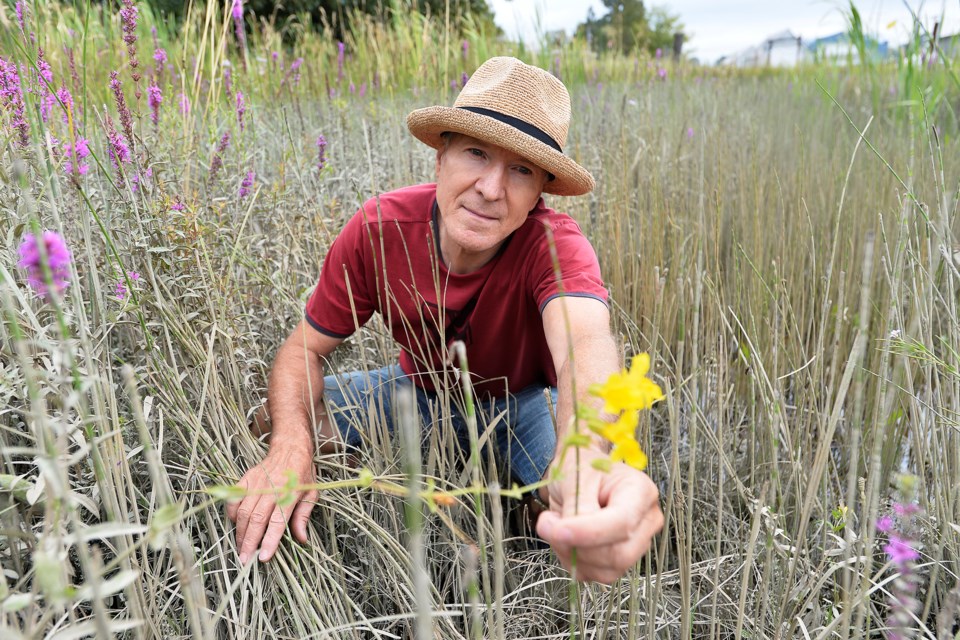Frank Lomer didn't have to swing from trees to discover a rare plant in in Queensborough.
Originally found on the Columbia River in Oregon, this particular yellow monkey flower has since been found on a handful of British Columbia sites on the Fraser River, including Delta, Burnaby and Queensborough.
“I think I have six sites marked but it’s probably a few more than that,” said the New West resident. “It’s rather rare. In Canada, those are the only sites.”
Originally lumped in with a common monkey flower, a botanist in Texas reviewed all the monkey flowers about eight years ago and changed some of their names – calling this one Erythranthe Scouleri.
“He still didn’t know much about it,” Lomer said. “He only knew it from the type specimen and from one or two collections in Oregon. It wasn’t known in Washington. He requested people to go and try and find this thing. He put this little paper out and said there were a lot of questions on Erythranthe and it needed more work on several species, and this was one.”
While reading the American botanist’s paper, Lomer realized he’d seen the plant growing in Queensborough and went to check it out.
“That’s what it is,” he said.
The plant grows up to two metres in height and has yellow flowers that bloom from about June to September, Lomer said.
“It grows only on the tidelands, where the water will come up in the high tide in New Westminster-Delta-Richmond,” he said. “It hasn’t been seen east of Coquitlam. It may be there.”
Lomer wrote about his discovery in an article published in a botanical journal earlier this year. He’s since spotted the plant in the marshlands of south Vancouver and expects there will be more sightings on the Fraser River.
“It’s great. It’s always exciting whenever I see something that I don’t recognize. It’s always interesting,” he said. “Usually every trip I see something I don’t know. I found poison ivy in Vancouver on the same little trip where I saw the monkey flower – poison ivy isn’t really known in Vancouver. That was the first site recorded.”
Lomer is concerned that rare plants on the Fraser River, like the yellow monkey flower, are threatened by development and could go extinct. He hope awareness about endangered Fraser River tidelands will help prevent that from occurring.
“My message would be to protect the Fraser River tidelands,” he said. “It isn’t good enough to build a development, destroy it all and say ‘we are going to compensate by building equal acreage on another part of the river by planting shrubs and trying to recreate a habitat’ because that habitat isn’t the same. That’s a phony habitat. You just planted a bunch of stuff there and it’s not what you destroyed.”
Each year, Lomer compiles about 300 to 400 plant collections, with about 10 of them being for plants that haven’t been noted before in B.C.
Lomer, who is retired, worked at the Stella-Jones mill in New Westminster. He once took a fish and wildlife program at BCIT that included a botany course, but said he’s basically a self-taught botanist.
“I am just curious about anything,” he said. “When I see something I don’t know, I want to identify it.”
While he’s loved exploring and searching for plants since he was a teenager, Lomer got serious about it in the 1980s when someone at the University of British Columbia suggested he collect plant specimens, press them and provide data such as when and where they were found.
“Now I’ve got 11,000 of those,” he said. “I am still doing about 300 a year.”
Hundreds of Lomer’s collections can now be found on the UBC Herbarium website.
“In the latter years, people have requested I go out and find stuff for them,” he said. “The Conservation Data Centre is a rare plant branch of the B.C. government – they often fund rare plant searches, so I have done a few of those.”
Erythrante Scouleri is now one of those plants listed on the Conservation Data Centre’s rare plant list, Lomer said.
“They keep track of all the rare plants,” he said. “They need to know where they are so whenever there is some issue with them or someone is doing a development, say on the Fraser River, it will be on a list of things to look for and supposedly protect it, or if they have to destroy it, collect seeds and move it to a similar habitat or create an identical habitat in another area. Just a conservation measure to protect it.”



